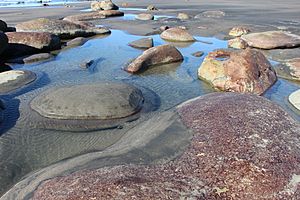Urenui facts for kids
Quick facts for kids
Urenui
|
|
|---|---|
| Country | New Zealand |
| Region | Taranaki Region |
| Territorial authority | New Plymouth District |
| Ward |
|
| Community | Clifton Community |
| Electorates |
|
| Area | |
| • Total | 3.65 km2 (1.41 sq mi) |
| Population
(June 2023)
|
|
| • Total | 430 |
| • Density | 117.8/km2 (305/sq mi) |
Urenui is a small town located in the northern part of Taranaki, on the North Island of New Zealand. It is found along State Highway 3, very close to the coast of the North Taranaki Bight. Urenui is about 13 kilometers east of Waitara and 6 kilometers southwest of Mimi. The Urenui River flows right past the town and into the North Taranaki Bight.
Contents
What Does the Name Urenui Mean?
The New Zealand Ministry for Culture and Heritage explains that the name Urenui means "great courage" in the Māori language. This meaning is a way of describing someone who is very brave. The name was given by a legendary chief named Manaia to honor his son.
A Brief Look at Urenui's History
Urenui was once the location of the Urenui Redoubt. This was a type of fort built in the winter of 1865 during the Second Taranaki War. At first, it was planned to be a place for Māori people who supported the colonial government to live. However, by 1866, it was decided that the town would become a settlement for soldiers instead.
Who Lives in Urenui?
Urenui is considered a rural settlement by Statistics New Zealand. It covers an area of about 3.65 square kilometers. As of 2018, the estimated population was around 414 people. This means there were about 113 people living in each square kilometer.
Population Changes Over Time
The number of people living in Urenui has changed a bit over the years:
- In 2006, there were 429 people.
- In 2013, the population was 432.
- In 2018, it decreased slightly to 414 people.
A Closer Look at the Community
In 2018, there were 186 households in Urenui. There were slightly more males (210) than females (198). About 15% of the people were under 15 years old. Around 30% of the population was 65 years or older.
Different Backgrounds in Urenui
The people of Urenui come from different backgrounds:
- About 89% identified as European or Pākehā.
- Around 20% identified as Māori.
- A small number identified with other ethnicities like Asian.
Beliefs and Work in Urenui
When asked about their religious beliefs, most people (55.8%) said they had no religion. About 31.9% were Christian. A small number followed other religions like Buddhism.
For those aged 15 and older, about 10% had a university degree. Around 23% did not have any formal qualifications. Many people in Urenui work full-time (43.6%), while some work part-time (12.8%).
What is a Marae?
A marae is a special meeting place for Māori people. It is a very important cultural and spiritual center. The Urenui Marae is located about 3 kilometers from the town. It is the only remaining marae for the Ngāti Mutunga tribe. The marae includes a meeting house called Te Aroha.
In October 2020, the New Zealand Government provided money to help upgrade the Urenui Marae. This project also helped create 21 jobs for people in the area.
Learning at Urenui School
Urenui School is a primary school for students in years 1 to 6. It welcomes both boys and girls. The school was first opened in 1876. In 2001, it celebrated its 125th anniversary!
Famous People from Urenui
Urenui has been home to some important people:
- Māui Pōmare: A well-known politician who worked to improve the lives of Māori people.
- Te Rangi Hīroa (Sir Peter Buck): A doctor and politician who was also a respected anthropologist.


